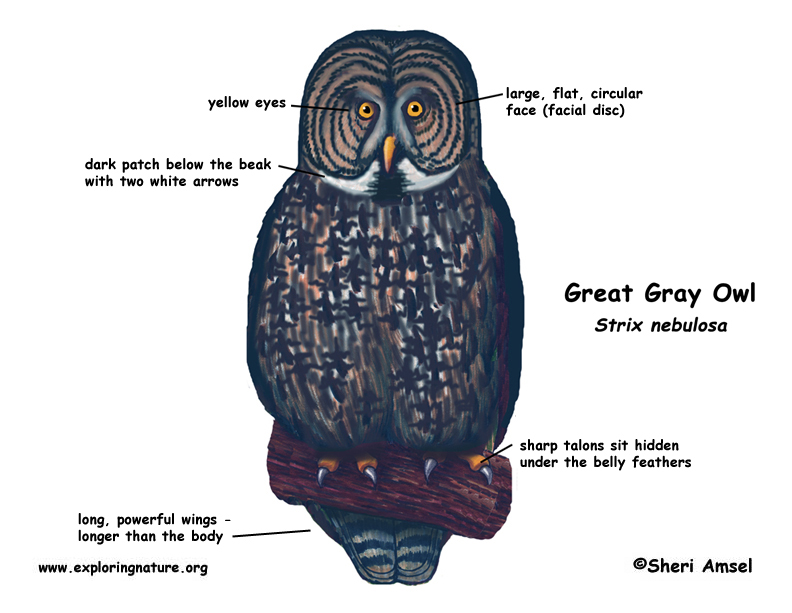

They are found in the northern boreal forests of the United States, Canada, Alaska and Northern Europe and Asia.
They live in mountainous areas with a mix of thick forest and open areas for hunting.
A large, dark grey owl covered with lighter speckling. They have long, powerful wings, which are longer than the body when perched and feathered feet with sharp claws (talons) that sit hidden under their belly feathers. They have a large, flat, circular face (facial disc) with yellow eyes and a dark patch below the beak with two white arrows “bowtie” - one on either side pointing outward. Their great size helps identify them. Males can reach almost 3 feet tall (85cm) – females are smaller. They have a huge wingspan reaching more than five feet wide. Yet, despite their huge size, they only weigh about three pounds.
They are active mostly early in the morning and late in the afternoon (corpuscular), marking their territory with a long “whoooo” call. They perch on poles, posts or snags watching for prey or flap slowly, close over the ground. They can detect prey movement under snow and will actually dive down through snow to catch them.
They mainly eat small rodents like mice and voles, but will take rabbits, squirrels, weasels, frogs, snakes and even sometimes birds. After they eat, they spit up (regurgitate) an “owl pellet” – a hard, gray pellet about 3” long that is made up of the bones, feather and fur of their prey held together with the owl’s body fluids. Educators often take them apart (dissect them) for students to observe what owls eat.
They are killed as eggs and hatchlings by other large owls, marten, fishers and even black bears. Adults can be killed by Canadian lynx or by being struck by a car while flying low across roadways.
Females lay up to 5 eggs in a tree cavity or a stick nest built by other birds. While the female keeps the eggs warm (incubates), the male brings food for her and their young. The female shreds the prey for the hatchlings to eat. Both male and female will defend the nest and stay together for life (monogamous). Babies will fly (fledge) after a few weeks, but first may jump or fall from the nest and climb back up.
They often live less than 10 years in the wild, but in captivity have been known to survive 40 years.
Kingdom: Animalia
Phylum: Chordata
Subphylum: Vetebrata
Class: Aves
Order: Strigiformes
Family: Strigidae
Genus: Strix
Species: S. nebulosa
When you research information you must cite the reference. Citing for websites is different from citing from books, magazines and periodicals. The style of citing shown here is from the MLA Style Citations (Modern Language Association).
When citing a WEBSITE the general format is as follows.
Author Last Name, First Name(s). "Title: Subtitle of Part of Web Page, if appropriate." Title: Subtitle: Section of Page if appropriate. Sponsoring/Publishing Agency, If Given. Additional significant descriptive information. Date of Electronic Publication or other Date, such as Last Updated. Day Month Year of access < URL >.
Amsel, Sheri. "Owl (Great Gray)" Exploring Nature Educational Resource ©2005-2024. December 14, 2024
< http://www.exploringnature.org/db/view/70 >

